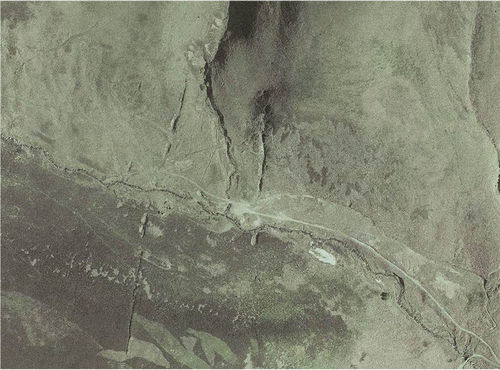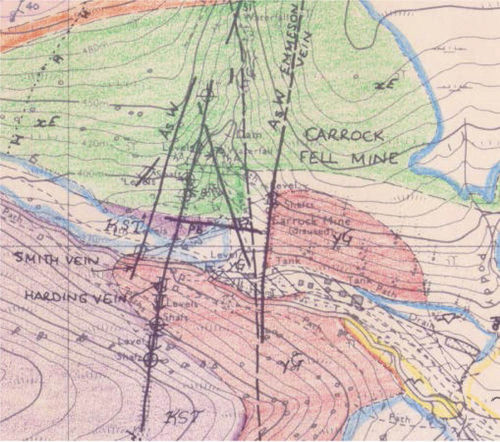OR/15/033 Introduction: Difference between revisions
m Protected "OR/15/033 Introduction" ([Edit=Allow only administrators] (indefinite) [Move=Allow only administrators] (indefinite)) [cascading] |
No edit summary |
||
| Line 2: | Line 2: | ||
{{OR/15/033}} | {{OR/15/033}} | ||
Carrock Mine is situated about 20 km west of Penrith and 10 km northeast of Keswick at NGR 332300;532940 (site of last mill) in the Caldbeck Fells of Cumbria. It is the only mine outside southwest England to have commercially mined tungsten ores in the British Isles. This was during several phases of working in the twentieth century, with first commercial mining of tungsten commencing around 1900 (Shaw; 1975, Tyler; 2003). The last phase of working ended in 1981 and the site was ‘restored’ by 1988 (Cooper; 1990). An account of the working of the mine is given by Tyler (2003). The main ores of tungsten present at the Carrock Mine are scheelite and wolframite, the former has not been worked commercially elsewhere in the UK. The area of the mine is shown in the aerial photograph (Figure 1). | Carrock Mine is situated about 20 km west of Penrith and 10 km northeast of Keswick at NGR 332300;532940 (site of last mill) in the Caldbeck Fells of Cumbria. It is the only mine outside southwest England to have commercially mined tungsten ores in the British Isles. This was during several phases of working in the twentieth century, with first commercial mining of tungsten commencing around 1900 (Shaw; 1975<ref name="Shaw">SHAW, W T. 1975. Mining in the Lake Counties; Dalesman Press 3rd edition 128p. </ref>, Tyler; 2003<ref name="Tyler">TYLER, I. 2003. Carrock and The Mines of Skiddaw and Blencathra.; Blue Rock Publications; 272p.</ref>). The last phase of working ended in 1981 and the site was ‘restored’ by 1988 (Cooper; 1990<ref name="Cooper 1990">COOPER, M P and STANLEY, C J. 1990. Minerals of the English Lake District. Caldbeck Fells; London: Natural History Museum; 160p. </ref>). An account of the working of the mine is given by Tyler (2003). The main ores of tungsten present at the Carrock Mine are scheelite and wolframite, the former has not been worked commercially elsewhere in the UK. The area of the mine is shown in the aerial photograph (Figure 1). | ||
[[Image:OR15033_fig1.jpg|thumb|center|500px|'''Figure 1''' Aerial photograph of the Carrock Mine site. Note the long line of surface workings on Harding Vein (west of centre) with two smaller surface workings further west on Smith Vein and those on Emerson Vein in the centre, east of Brandy Gill Beck. The mill was in the centre of the image (NE of the confluence of Brandy Gill Beck with Grainsgill Beck and tailings of various vintages can be seen at the mill site and to the east both south of Graingill Beck (white) and north of the mine access road (red-brown). Width of image approximately 825m. Aerial photography ©UKP/Getmapping Licence No. UKP2006/01.]] | [[Image:OR15033_fig1.jpg|thumb|center|500px|'''Figure 1''' Aerial photograph of the Carrock Mine site. Note the long line of surface workings on Harding Vein (west of centre) with two smaller surface workings further west on Smith Vein and those on Emerson Vein in the centre, east of Brandy Gill Beck. The mill was in the centre of the image (NE of the confluence of Brandy Gill Beck with Grainsgill Beck and tailings of various vintages can be seen at the mill site and to the east both south of Graingill Beck (white) and north of the mine access road (red-brown). Width of image approximately 825m. Aerial photography ©UKP/Getmapping Licence No. UKP2006/01.]] | ||
| Line 10: | Line 10: | ||
[[Image:OR15033_fig2.jpg|thumb|center|500px|'''Figure 2''' Extract from BGS 1:10,000 scale geological standard of the Carrock Mine area (re- mapped in 1990) showing similar area to Figure 1. (Purple KST = Kirk Stile Formation (Skiddaw Group) mainly hornfelsed; Green xE = Gabbro and Hornfelsed contact gabbro (Mosedale Division); Red yG = greisenised granite (Skiddaw Intrusion); areas outlined in blue = till and areas outlined in yellow = alluvium).]] | [[Image:OR15033_fig2.jpg|thumb|center|500px|'''Figure 2''' Extract from BGS 1:10,000 scale geological standard of the Carrock Mine area (re- mapped in 1990) showing similar area to Figure 1. (Purple KST = Kirk Stile Formation (Skiddaw Group) mainly hornfelsed; Green xE = Gabbro and Hornfelsed contact gabbro (Mosedale Division); Red yG = greisenised granite (Skiddaw Intrusion); areas outlined in blue = till and areas outlined in yellow = alluvium).]] | ||
It is beyond the scope of this report to describe the local geology in detail. For a summary see Appleton and Wadge (1976) and Figure 2. | It is beyond the scope of this report to describe the local geology in detail. For a summary see Appleton and Wadge (1976) and Figure 2. The tungsten mineralisation is hosted in a series of strong north-south quartz veins. The mineralisation is associated with a greisenised intrusion, which is part of the Skiddaw Granite (ca 380 ma). In the locality of the mine this granite was intruded into Ordovician Skiddaw Slates which had been previously contact metamorphosed to hornfels by the Carrock Fell Complex gabbro intrusion (ca 470 ma). The veins worked in the mine are hosted by the granite in the south, gabbro to the north and a narrow zone of hornfelsed Skiddaw Slate in between. The tungsten bearing veins are cut by a suite of later, narrow ‘lead’ veins, not exploited by the mine. These lead veins were exploited in the 19th century, and perhaps earlier as a separate venture (Tyler; 2003<ref name="Tyler"></ref>). | ||
The underground geology of the workings, up until about 1977 (4 years prior to closure), was published by Moore (1977) and the work reported here focuses on the mine workings that postdate his paper. Field work and limited laboratory analysis was supported by the Lake District National Park Authority and Natural England. | The underground geology of the workings, up until about 1977 (4 years prior to closure), was published by Moore (1977) and the work reported here focuses on the mine workings that postdate his paper. Field work and limited laboratory analysis was supported by the Lake District National Park Authority and Natural England. | ||
An MSc project, examining water chemistry and tungsten vein mineralisation, was undertaken by a Loughborough University chemistry student in 2013 using water samples and some of the mineral samples collected at the time of the underground survey (Tarip; 2013). | An MSc project, examining water chemistry and tungsten vein mineralisation, was undertaken by a Loughborough University chemistry student in 2013 using water samples and some of the mineral samples collected at the time of the underground survey (Tarip; 2013<ref name="Tarip">TARIP, N H H. 2013. Determination of Water Chemistry & Characterisation of Minerals from the Disused Carrock Tungsten Mine; M.Sc. dissertation, Department of Chemistry, Loughborough University. </ref>). | ||
==References== | |||
[[category:OR/15/033 The Underground Geology of part of the Carrock Tungsten Mine, Caldbeck Fells | 01]] | [[category:OR/15/033 The Underground Geology of part of the Carrock Tungsten Mine, Caldbeck Fells | 01]] | ||
Revision as of 14:01, 28 July 2015
| Shaw, R P. 2015. The Underground Geology of part of the Carrock Tungsten Mine, Caldbeck Fells. British Geological Survey Internal Report, OR/15/033. |
Carrock Mine is situated about 20 km west of Penrith and 10 km northeast of Keswick at NGR 332300;532940 (site of last mill) in the Caldbeck Fells of Cumbria. It is the only mine outside southwest England to have commercially mined tungsten ores in the British Isles. This was during several phases of working in the twentieth century, with first commercial mining of tungsten commencing around 1900 (Shaw; 1975[1], Tyler; 2003[2]). The last phase of working ended in 1981 and the site was ‘restored’ by 1988 (Cooper; 1990[3]). An account of the working of the mine is given by Tyler (2003). The main ores of tungsten present at the Carrock Mine are scheelite and wolframite, the former has not been worked commercially elsewhere in the UK. The area of the mine is shown in the aerial photograph (Figure 1).

When the mine’s mill and dressing floor site was cleared and restored in 1988 the entrances to the main mine levels were blocked, though access for mine explorers was still possible. Because of concerns about contamination of Grainsgill Beck, which flows past the mine, by mine drainage waters, the entrance to the main haulage level (No 1 Level) was cleared and restored to its pre-1988 condition by Cumbria Amenity Trust Mining History Society (CATMHS) with financial support for materials from the Lake District National Park and Natural England. All levels are gated for safety.

It is beyond the scope of this report to describe the local geology in detail. For a summary see Appleton and Wadge (1976) and Figure 2. The tungsten mineralisation is hosted in a series of strong north-south quartz veins. The mineralisation is associated with a greisenised intrusion, which is part of the Skiddaw Granite (ca 380 ma). In the locality of the mine this granite was intruded into Ordovician Skiddaw Slates which had been previously contact metamorphosed to hornfels by the Carrock Fell Complex gabbro intrusion (ca 470 ma). The veins worked in the mine are hosted by the granite in the south, gabbro to the north and a narrow zone of hornfelsed Skiddaw Slate in between. The tungsten bearing veins are cut by a suite of later, narrow ‘lead’ veins, not exploited by the mine. These lead veins were exploited in the 19th century, and perhaps earlier as a separate venture (Tyler; 2003[2]).
The underground geology of the workings, up until about 1977 (4 years prior to closure), was published by Moore (1977) and the work reported here focuses on the mine workings that postdate his paper. Field work and limited laboratory analysis was supported by the Lake District National Park Authority and Natural England.
An MSc project, examining water chemistry and tungsten vein mineralisation, was undertaken by a Loughborough University chemistry student in 2013 using water samples and some of the mineral samples collected at the time of the underground survey (Tarip; 2013[4]).
References
- ↑ SHAW, W T. 1975. Mining in the Lake Counties; Dalesman Press 3rd edition 128p.
- ↑ 2.0 2.1 TYLER, I. 2003. Carrock and The Mines of Skiddaw and Blencathra.; Blue Rock Publications; 272p.
- ↑ COOPER, M P and STANLEY, C J. 1990. Minerals of the English Lake District. Caldbeck Fells; London: Natural History Museum; 160p.
- ↑ TARIP, N H H. 2013. Determination of Water Chemistry & Characterisation of Minerals from the Disused Carrock Tungsten Mine; M.Sc. dissertation, Department of Chemistry, Loughborough University.